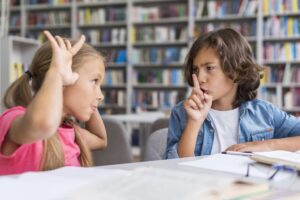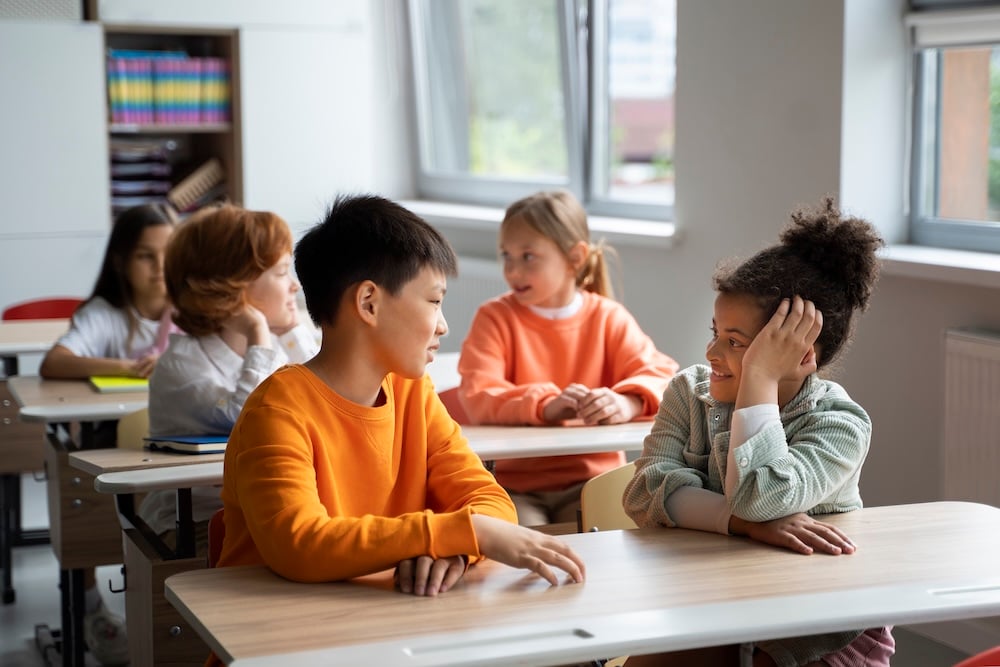Conflict is a natural part of growing up. Whether it’s a disagreement over sharing supplies, a miscommunication on the playground, or a clash of opinions in group work, students are constantly navigating relationships. But with the right tools and guidance, these moments can become powerful learning opportunities.
This is where educators and school staff play a vital role. Instead of stepping in to fix every disagreement, we can give students the tools to solve conflicts independently—building their confidence, empathy, and problem-solving skills.
In this article, we’ll explore practical, age-appropriate conflict resolution strategies for students, how adults can support without taking over, and how programs like Soul Shoppe’s Peacemaker Training, Tools of the Heart, and Planet Responsibility equip students to build peaceful, connected communities.
Why Conflict Resolution Belongs in the Classroom
When students learn to manage conflict early on, they’re not just solving problems—they’re developing lifelong skills:
✔ Listening with empathy
✔ Communicating clearly and kindly
✔ Taking responsibility for their actions
✔ Finding creative, respectful solutions
By nurturing conflict resolution in educational settings, we create classrooms that are not only calmer but also more connected.
Conflict Resolution Strategies for Elementary Students

1. Use a Step-by-Step Process
Teach students a simple, repeatable method for working through problems. Soul Shoppe’s “I Message” framework or Peace Path tools are great examples:
- Stop and breathe
- Say how you feel
- Say what happened (without blame)
- Listen to the other person
- Work together on a solution
This process is at the heart of our Peacemaker Training—a program that helps students take on leadership roles in resolving peer conflicts, with guidance from trusted adults.
2. Practice with Conflict Resolution Scenarios for Students
Role-playing is a powerful way to prepare students for real-life challenges. Try these conflict resolution scenarios for students:
- “Your partner didn’t do their part in a group project—what do you do?”
- “Two friends both want the same ball during recess—how can they solve it together?”
- “Someone made a joke that hurt your feelings—how can you tell them in a kind way?”
Walk through these with the class or in small groups, using role-play and reflection to build empathy.
3. Empower Students with a Mediation Role
Student conflict resolution becomes even more effective when students lead it. That’s why we train Peacemakers—students who learn how to teach mediation, guide peers through conflict, and model respectful behavior.
With guidance, students can even complete a student mediation agreement outlining what happened, what each person needs, and what steps they’ll take moving forward.
How Adults Can Support Without Taking Over
When students are in conflict, adults may feel the urge to step in and fix the problem. But with support and guidance, students can often work it out themselves. Here’s how to help:
Coach, Don’t Control
Instead of directing the conversation, ask questions that guide students toward solutions:
- “What do you think happened?”
- “How do you think they felt?”
- “What would be a fair way to move forward?”
Stay Neutral and Present
Avoid taking sides or assigning blame. Be a calm, supportive presence that reassures students they are safe and capable of working through the issue.
Model Reflective Listening
Demonstrate how to truly listen by reflecting what a student says:
- “So you’re feeling frustrated because…”
- “You wanted to play, but they didn’t hear you?”
Modeling these skills teaches students how to do the same for each other.
Integrating Conflict Resolution into Daily Classroom Life
Teaching classroom conflict resolution isn’t a one-time lesson—it’s a culture. Build it into your daily rhythm with these ideas:
Start the Day with a Check-In
Use feelings charts or morning circles to help students share what they’re carrying into the day.
Create a Classroom Agreement Together
Let students co-create the classroom norms. This builds ownership and a shared commitment to kindness and responsibility.
Play Conflict Resolution Games
Games help students build skills in a fun and low-pressure way. Try some conflict resolution games for kids—designed to encourage empathy, problem-solving, and collaboration.
Tools and Programs that Support Student-Led Conflict Resolution
Soul Shoppe offers structured programs that help embed conflict resolution strategies for students in a sustainable and meaningful way:
Peacemaker Training
Peacemaker Training is a whole-school model for how to resolve conflict in school—empowering students as peer mediators and providing staff with tools to guide peaceful resolution.
Tools of the Heart
Tools of the Heart is a social-emotional learning curriculum that teaches emotional awareness, communication skills, and self-regulation—all foundational for conflict management in schools.
Planet Responsibility
Planet Responsibility gives students a framework for understanding how their actions affect others and how they can take ownership and make things right. It’s about turning mistakes into meaningful growth.
Let Students Lead with Our Support
Conflict isn’t something to avoid—it’s something to grow through. With the right structures in place, strategies to resolve conflict, and trusted adults modeling compassion and respect, students become confident in their ability to navigate challenges.
By teaching conflict resolution strategies for students, we’re not just creating more peaceful classrooms—we’re shaping compassionate, courageous leaders.
Let’s give them the tools—and the trust—to lead the way. To learn more, contact us!
You May Also Like:
Classroom Culture: How To Build A Peaceful And Welcoming Space
Teaching Assertiveness vs. Aggressiveness


